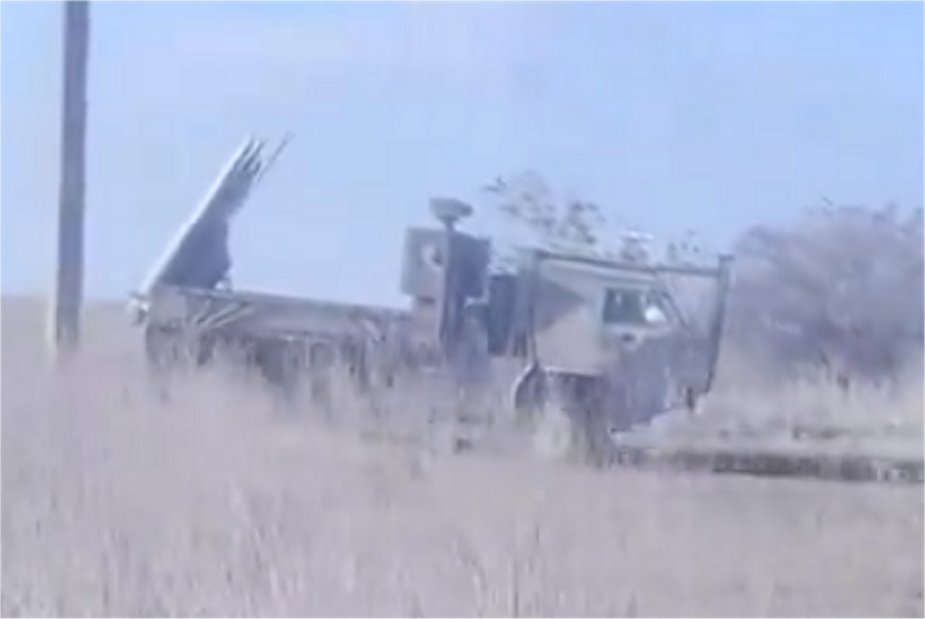A video that recently surfaced on the Telegram channel @Supernova_plus displays an advanced British air defense system equipped with the Advanced Short Range Air-to-Air Missile (ASRAAM) on the battlefield in Ukraine. This air defense system, mounted on a Supacat chassis, was quickly developed by MBDA experts. It represents one of the improvised British contributions to Ukraine, adapting an air-launched missile for ground-based launchers.
Follow Army Recognition on Google News at this link

The ASRAAM missile mounted on a Supacat chassis spotted in Ukraine (Picture source: Telegram channel @Supernova_plus )
This marks the first daytime observation of the defense system in Ukraine, following a previous sighting of its use against Russian Kamikaze Drones in October 2023, after the UK announced the delivery of ASRAAM systems.
The ASRAAM missile is in service with air forces from the United Kingdom, India, Qatar, Oman, and has been integrated into Australia’s F/A-18 Hornet fleet. In its ground-based configuration, the missile's operational range is decreased. Each launcher can hold up to two ASRAAM missiles, with targeting supported by Chess Dynamics' Hawkeye electro-optical tracking system.
The primary goal of deploying this advanced system in Ukraine is to directly counter Russian drones and attack helicopters on the battlefield, protecting Ukrainian forces from aerial bombardments and assaults. The ASRAAM, an infrared-guided missile, is primarily operated by the Royal Air Force (RAF) and the Royal Australian Air Force (RAAF).
Designed to intercept and neutralize enemy aircraft at short distances, the ASRAAM can be launched from various platforms, including fighter jets, helicopters, and drones. Originally an air-to-air weapon, the AIM-132 ASRAAM system has proven adaptable to ground-launch scenarios. This adaptability is due to its advanced off-boresight (HOBS) seeker and lock-on-after-launch (LOAL) capability, supported by a data link, allowing the missile to effectively identify, track, and neutralize targets not directly in its launch trajectory. The British-made ASRAAM is a maneuverable, heat-seeking missile designed for air-to-air engagement, widely used by the RAF and the Royal Navy's Fleet Air Arm.
The missile can be mounted on various platforms, including aircraft and ground-based systems. While typically fitted to fighter aircraft like the Eurofighter Typhoon and the F-35 Lightning II, it has also been adapted for use on ground platforms such as the Supacat High Mobility Transporter (HMT) truck, as shown in the video. The Supacat HMT is a versatile, all-terrain military vehicle used for reconnaissance, troop transport, and command and control. Its mobility and payload capacity makes it suitable for carrying and launching missile systems.
When mounted on a Supacat HMT truck, the ASRAAM provides a mobile and adaptable air defense capability. The truck can quickly transport the missile system to various locations, enabling rapid response to aerial threats. Furthermore, the ASRAAM missile's advanced targeting and guidance systems, combined with the stability and maneuverability of the Supacat HMT, create an effective platform for engaging enemy aircraft. The ASRAAM features a cutting-edge infrared homing seeker sensitive to mid-wave and long-wave infrared emissions, enhancing its target detection and tracking capabilities across different backgrounds, including land, sky, and sea. Its propulsion is powered by a solid rocket motor, offering a high thrust-to-weight ratio for rapid acceleration.
The missile's design minimizes drag for optimal aerodynamic performance, and thrust-vectoring controls provide exceptional maneuverability, enabling evasion of enemy countermeasures and missiles.
Data-link capabilities allow for mid-course guidance updates, improving accuracy and enabling more flexible engagement strategies. Internally, the ASRAAM is equipped with an advanced electronic counter-countermeasures (ECCM) suite to resist jamming and other electronic warfare tactics. Its warhead is designed to defeat modern aircraft, utilizing a proximity fuse for detonation at the optimal moment for maximum effect. Although classified as a short-range missile, the ASRAAM's effective engagement range extends beyond visual range (BVR), allowing operators to engage threats before visual contact. Open source information indicates it has a range of up to 25 km and can achieve a maximum speed of Mach 3.
Defense News February 2024
















